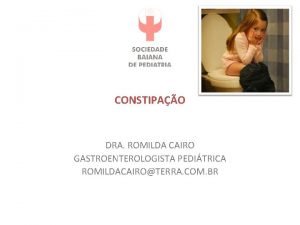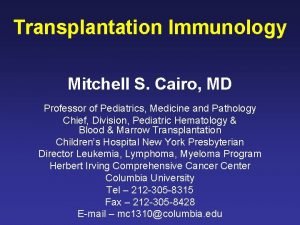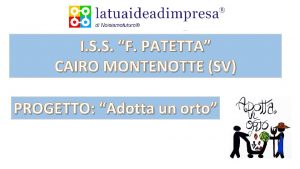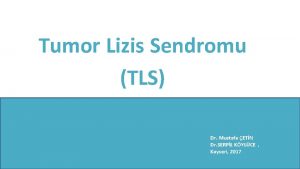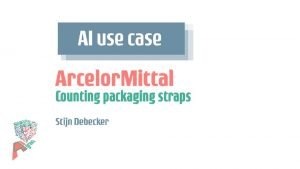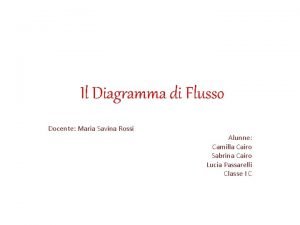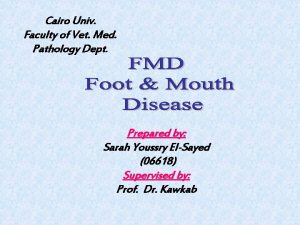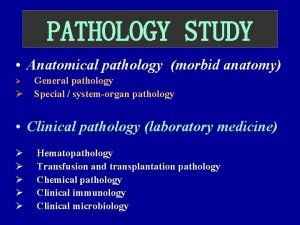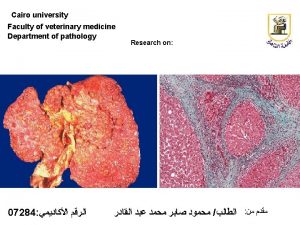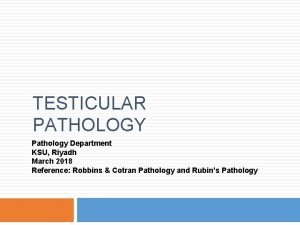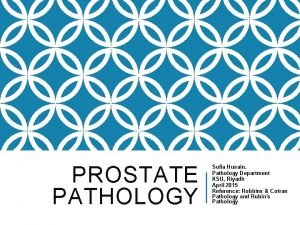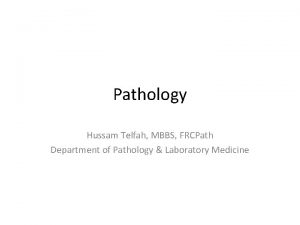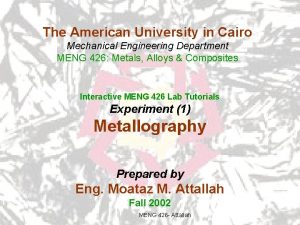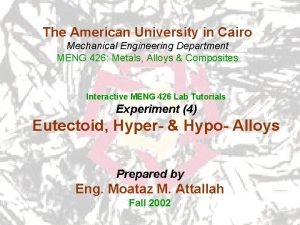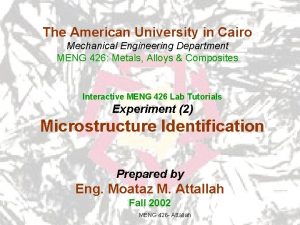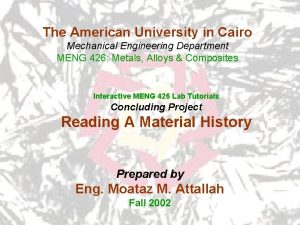Welcome In Cairo university Department of Pathology Faculty
































- Slides: 32

Welcome In Cairo university

Department of Pathology Faculty of veterinary medicine

Histopathology Techniques Introduced By • Dr. Sherein Saied Abdelgayed • Assistant Professor • Department of Pathology • Faculty of veterinary medicine • Cairo university •

Histopathology Techniques: Tissue Processing and Staining • Method of Biopsy Taking: • 1. Incisional biopsy • 2. Excisional biopsy • 3. Punch biopsy • 4. Core needle biopsy • 5. Curettage biopsy •

Incisional biopsy: * It is performed when removal of • entire lesion is impossible. * Often performed prior to major • surgical procedure. * Is strictly a diagnostic nature. •

Excisional Biopsy: * In this technique, the entire lesion is • removed, usually with a rim of normal tissue. * It is performed when the lesion is • smaller in size. * The procedure serves the diagnostic • and therapeutic function.

Punch Biopsy: * It is done by biopsy forceps. • * It is performed in the lesion • of uterine cervix, oral cavity, esophagus, stomach, intestine and bronchus.

Core Needle Biopsy: * It is done with special • type of wide bore biopsy needle. * It permits a percutaneous • proach to internal structures •

Curettage Biopsy: Curetting are • usually done for diagnosis of endometrial disease.

Some General Rules for the biopsy Procedure: 1. The larger the lesion, the numerous • the biopsies that should be taken from it because of the fact that the diagnostic areas may be present only focally. 2. In ulcerated tumour, Biopsies should • be taken from the periphery that includes normal and diseased tissue.

Some General Rules for the biopsy Procedure: 3. Crushing or squeezing of the • tissue with forceps should be carefully avoided. 4. Once the biopsy is obtained, • it should be placed immediately into container with adequate volume of fixative. •

Handling of Specimen * Specimen should be transported in • glass, plastic or metal container or in a plastic bag in 10%formalin. If formalin is not available at hand, place the specimen in refrigerator at 4 o. C to slow down autolysis. *The container should have an opening • larger enough so that the tissue can be removed easily after it has • hardened by fixation. •

General Principle of Gross Examination: 1. Proper identification and orientation • of the specimen. 2. Unlabelled specimen should never be • processed. 3. A properly completed histopathology • requisition form containing patient’s name, age, sex, relevant clinical data, surgical findings, nature of operation and name of tissue submitted.

General Principle of Gross Examination: 4. Careful search and examination of all the • tissue submitted in order. 5. Place the specimen on cutting board in an • anatomic position and record the following information: • a. Types of specimen b. Structure included. • c. Dimensions d. Weight • e. Shape f. Colour • g. Consistency • h. Surgical margin, whether included • or not involved by tumour. •

General Principle of Gross Examination: 6. Measurements are usually given • in centimeter unless the specimen is very small in which mm can be used. 7. Endometrial and prostatic tissue • should be measured by aggregate pieces in volume.

Sampling for Histopathological Examination: *Tissue submitted for histopathology must not • be more than 3 mm thick and not larger than the diameter of slides used. Most specimens from solid tissues are cut in the form of pieces measuring 10 to 15 mm on the slides • and 2 to 3 mm in thickness. *Discrete areas of calcification or ossification • should be taken out and should be decalcified in nitric acid. agments of tissue must be wrapped in thin paper. •

Histological Technique: *Histological technique deals with the preparation of tissue for microscopic examination. • *The aim of good histological technique to preserve microscopic anatomy of tissue. • • *This is achieved by passing through a series of • process. These processes are: • 1. Fixation 2. Dehydration • 3. Cleaning 4. Embedding • 5. Cutting 6. Staining •

. Fixation Difinition: • *This is the process by which the • constituents of cells and tissue are fixed in a physical and a chemical state so that they will withstand subsequent treatment with various reagents with minimum loss of architecture. is achieved by exposing the tissue to chemical compounds, call fixatives •

Fixation Mechanism of action of fixatives: • *Most fixatives act by precipitating proteins • *No fixative will penetrate a piece of tissue thicker than • 1 cm. *For dealing with specimen thicker than this, following • methods are recommended: 1. Solid organ: Cut slices as necessary as but not thicker • than 5 mm. 2. Hollow organ: Either open or fill with fixative or pack • lightly with wool soaked in fixative. men, Inject fixative along the vessels or • case of lung so that it reaches all parts of the organ

Properties of an Ideal Fixative: 1. Prevents autolysis and bacterial decomposition. • 2. Preserves tissue in their natural state and fix all • components. 3. Make the cellular components insoluble to reagent • used in tissue processing. 4. Preserves tissue volume. • 5. Avoid excessive hardness of tissue. • 6. Allows enhanced staining of tissue. • 7. Should be non-toxic and non-allergic for user. • 8. Should not be very expensive. • •

Amount of fixative fluid: *This should be • approximately 10 -20 times the volume of the specimen. *Fixative should surround • the specimen on all sides. • •

Classification of Fixatives A. Tissue fixatives • a. Buffered formalin b. Buffered gluteraldehyde • c. Zenker’s formal saline d. Bowen’s fluid • B. Cytological fixatives • a. Ethanol b. Methanol c. Ether • C. Histochemical fixatives • a. Formal saline b. Cold acetone • c. Absolute alcohol •

Tissue Processing: *Tissue processing is a long procedure and • required 24 hours. Tissue processing can be done by manually or mechanically. *It is done in stages. It can be subdivided • into; dehydration, clearing, impregnating and embedding. *It is important that all specimens are • properly labeled before processing is started. • *For labeling, pen containing ordinary ink • ot be used. Printed, or graphite pencil written, are satisfactory. •

Sequence of manual tissue processing: A. Dehydration: • *Tissues are dehydrated by using • increasing strength of alcohol; e. g. 50%, 70%, 90% and 100%. *The duration for which tissues are kept • in each strength of alcohol depends upon the size of tissue, fixative used and type of tissue. *The volume of alcohol should be 50 • 100 times that of tissue. • •

B. Clearing: *The next step alcohol should be replaced by paraffin wax. *As paraffin wax is not alcohol soluble, we replace • alcohol with a substance in which wax is soluble. This step is call clearing. • *Clearing of tissue is achieved by any of the following reagents: • Xylene Chloroform Benzene • • Carbon tetrachloride Toluene • *Xylene is commonly used. • *Small piece of tissue are cleaned in 0. 5 – 1 hour; • *whereas larger (5 cm or more thick) are • cleaned in 2 -4 hours. • • •

C. Impregnation with Wax: *This is allowed to occur at melting point temperature of paraffin wax, which is 54 -60 o. C. * Volume of wax should be about 25 -30 times the • volume of tissues. *The duration of impregnation depends on size and • types of tissues and the clearing agents employed. *Total duration of 4 hours is sufficient for routine • impregnation. • *Types of Wax employed for Impregnation: • 1. Paraffin wax 2. Water soluble wax • *Paraffin wax is used routinely. It has hard • section of 3 -4 micron thickness can be cut. •

D. Blocking: *Impregnated tissues are placed in a mould • with their labels and then fresh melted wax is poured in it and allowed to settle and solidify. Once the block has cooled sufficiently to form a surface skin it should be immersed in cold water to cool it rapidly. *After the block has completely cooled it is • cut into individual blocks and each is trimmed. • *Labels are made to adhere on • the surface of the block. •

Staining: *Staining is a process by which we give colour to a section. *There are hundreds of stains available. *Classification of Stains: • Generally the stains are classified as: • A. Acid stains B. Basic stains • C. Neutral stains •

Classification of Stains: Acid Dyes: • *In an acid dye the basic component is coloured and the acid component is colourless. *Acid dyes stain basic components • *e. g. eosin stains cytoplasm red. • Basic Dyes: • *In a basic dye the acid component is coloured and the basic component is colourless. *Basic dyes stain acidic components • *e. g. basic fuchsin stains nucleus blue. • • • Neutral Dyes: • *When an acid dye is combined with a basic dye a neutral dye is formed. *As it contains both coloured radicals, it gives • different colours to cytoplasm and nucleus • simultaneously. This is the basis of Leishman stain. • •

Procedure of staining *Every stain is to be used according • to a specified method. *Staining can be done either manually • or in an automatic stainer. *Haematoxylin and Eosin staining: • the most common used routine • stain in histopathology laboratory

Special Stains: 1. PAS (Periodic Acid Schiff) stain: This stain demonstrates glycogen 2. Stains for micro-organism: • a. Gram-stain: • b. Ziehl_Neelsen stain: This stain detect acid fast bacilli. • c. PAS stain: It is used for fungi, amoeba and Tricomonas. • d. Modified Giemsa (2% Giemsa in water): For Helicobacter pylori. • 3. Congo-red: It is used for identification of amyloid. • 4. Sudan-Black: It is used for fat staining. • 5. Masson’s Trichrome: It is used for differentiation of • connective tissue • • •

Thank you
 Faculty of veterinary medicine cairo university logo
Faculty of veterinary medicine cairo university logo Faculty of veterinary medicine cairo university
Faculty of veterinary medicine cairo university Cairo university faculty of veterinary medicine
Cairo university faculty of veterinary medicine American university in cairo history
American university in cairo history Nit calicut chemistry
Nit calicut chemistry Virtual pathology at the university of leeds
Virtual pathology at the university of leeds New cairo british international school
New cairo british international school Kairos y cronos en la biblia
Kairos y cronos en la biblia Dra romilda cairo
Dra romilda cairo Mitchell cairo md
Mitchell cairo md Le meridien cairo airport wedding packages
Le meridien cairo airport wedding packages Iss cairo
Iss cairo Relative location of cairo egypt
Relative location of cairo egypt Dr serpil köylüce
Dr serpil köylüce Brt cairo
Brt cairo Victor cairo arcelormittal
Victor cairo arcelormittal Multinational state ap human geography definition
Multinational state ap human geography definition Sabrina cairo
Sabrina cairo Herszon kherson maritime college of merchant marine fleet
Herszon kherson maritime college of merchant marine fleet University of bridgeport computer science
University of bridgeport computer science University of bridgeport engineering
University of bridgeport engineering Hubert kairuki memorial university faculty of medicine
Hubert kairuki memorial university faculty of medicine Semmelweis
Semmelweis Applied medical sciences
Applied medical sciences Computer science fsu
Computer science fsu Faculty of business and economics mendel university in brno
Faculty of business and economics mendel university in brno Singularity university faculty
Singularity university faculty Agnes csaki semmelweis
Agnes csaki semmelweis Masaryk university medical faculty
Masaryk university medical faculty Feup university of porto
Feup university of porto Charles university faculty of humanities
Charles university faculty of humanities Faculty of law of the university of zagreb
Faculty of law of the university of zagreb University of montenegro faculty of law
University of montenegro faculty of law








